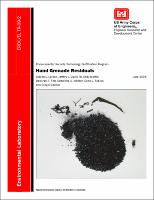Please use this identifier to cite or link to this item:
https://hdl.handle.net/11681/6921| Title: | Hand grenade residuals |
| Authors: | Larson, Steven L. Davis, Jeffrey L. Martin, W. Andy Felt, Deborah R. Nestler, Catherine C. Fabian, Gene L. O'Connor, Gregory |
| Keywords: | Grenades Explosives, Military--Residues |
| Publisher: | Environmental Laboratory (U.S.) Engineer Research and Development Center (U.S.) |
| Series/Report no.: | ERDC/EL ; TR-09-2. |
| Abstract: | Abstract: The Department of Defense operates hundreds of hand grenade ranges for training purposes. The majority of hand grenades used at fixed position ranges are fragmentation grenades that are typically composed of a steel shell and composition B explosive material. Measurable explosive levels have been observed in hand grenade range soils at levels in the low parts per billion up to percent levels. Previous attempts to measure hand grenade residues have used snow, tarps, and trays as collection media, but each method had some disadvantages. In this research, hand grenades were detonated in a large octagon test chamber at the Aberdeen Training Center, allowing for a more complete collection of the debris. Initially, residues from two hand grenades were analyzed for explosives and metals by the U.S. Army Engineer Research and Development Center, Vicksburg. Residues from 30 hand grenades were analyzed for explosives and metals content. On average, the mass of RDX associated with the hand grenade residue was 0.366 mg with a 101-percent recovery of the iron that composes the steel grenade shell. The results from this study will help determine the potential soil loading of residuals on grenade training ranges. |
| Description: | Technical Report |
| URI: | http://hdl.handle.net/11681/6921 |
| Appears in Collections: | Technical Report |
Files in This Item:
| File | Description | Size | Format | |
|---|---|---|---|---|
| EL-TR-09-2.pdf | 1.36 MB | Adobe PDF |  View/Open |